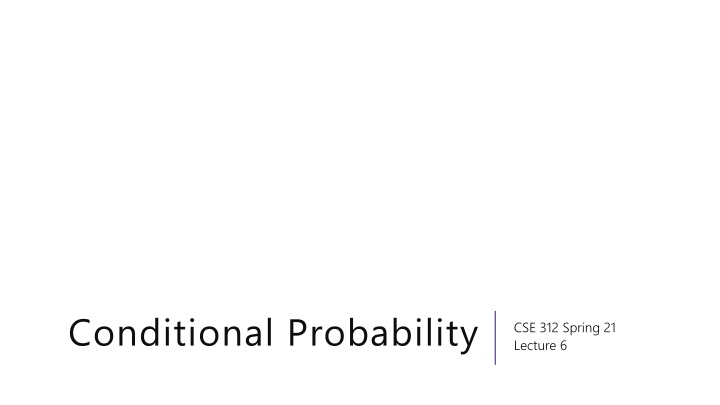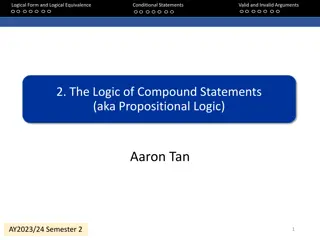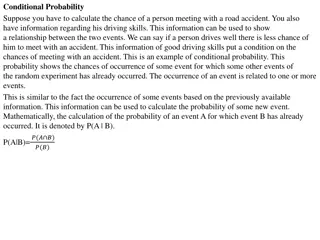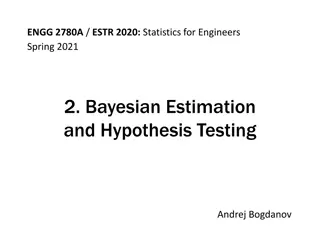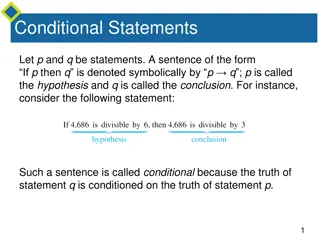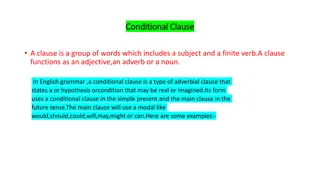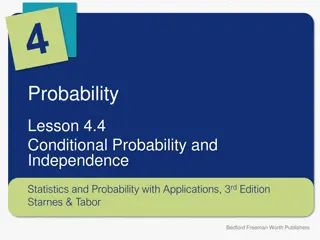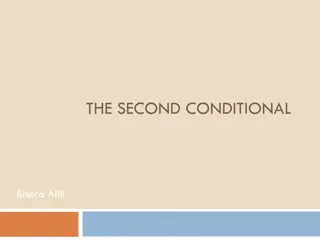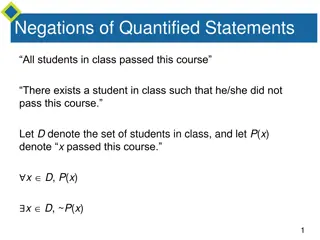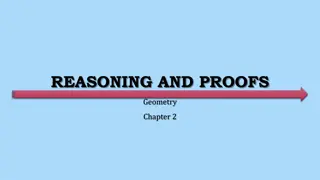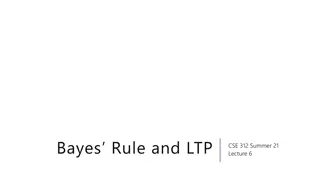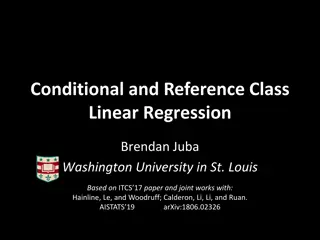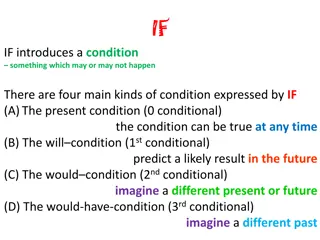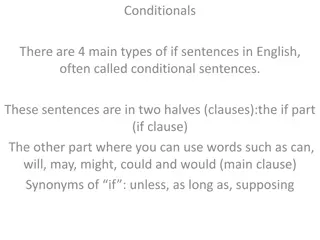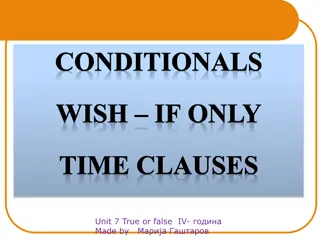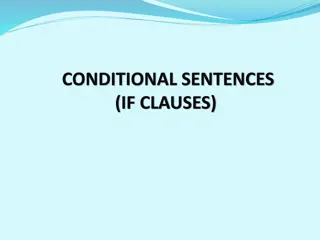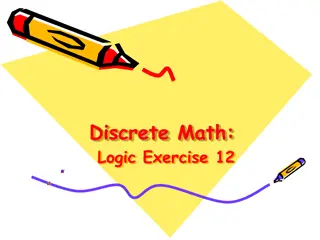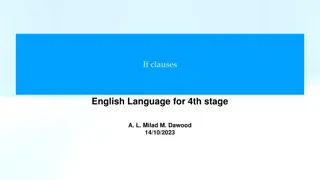Conditional Probability
Examples of conditional probability by analyzing the likelihood of rolling two dice with various conditions such as both dice being even or having the same value. The concepts of sample space, probability measures, events, and calculating probabilities are illustrated to deepen understanding in probability theory.
Download Presentation

Please find below an Image/Link to download the presentation.
The content on the website is provided AS IS for your information and personal use only. It may not be sold, licensed, or shared on other websites without obtaining consent from the author.If you encounter any issues during the download, it is possible that the publisher has removed the file from their server.
You are allowed to download the files provided on this website for personal or commercial use, subject to the condition that they are used lawfully. All files are the property of their respective owners.
The content on the website is provided AS IS for your information and personal use only. It may not be sold, licensed, or shared on other websites without obtaining consent from the author.
E N D
Presentation Transcript
Conditional Probability CSE 312 Spring 21 Lecture 6
More Examples! Suppose you roll two dice. Each die is fair and they don t affect each other. What is the probability of both dice being even? What is your sample space? What is your probability measure ? What is your event? What is the probability?
More Examples! Suppose you roll two dice. Each die is fair and they don t affect each other. What is the probability of both dice being even? What is your sample space? 1,2,3,4,5,6 {1,2,3,4,5,6} What is your probability measure ? ? = 1/36 for all ? What is your event? 2,4,6 {2,4,6} What is the probability? 32/62
More Examples! Suppose you roll two dice. Each die is fair and they don t affect each other. What is the probability of both dice being even? What if we can t tell the dice apart and always put the dice in increasing order by value. What is your sample space? { 1,1 , 1,2 , 1,3 , 1,4 , 1,5 , 1,6 , 2,2 , 2,3 , 2,4 , 2,5 ,(2,6) 3,3 , 3,4 , 3,5 , 3,6 , 4,4 , 4,5 , 4,6 , 5,5 , 5,6 ,(6,6)} What is your probability measure ? (?,?) = 2/36 if ? ?, ?,? = 1/36 What is your event? { 2,2 , 4,4 , 6,6 , 2,4 , 2,6 , 4,6 } What is the probability? 3 36+ 3 1 2 36= 9 36
Takeaways There is often more than one sample space possible! But one is probably easier than the others. Finding a sample space that will make the uniform measure correct will probably make finding the probabilities easier to calculate.
Another Example Suppose you shuffle a deck of cards so any arrangement is equally likely. What is the probability that the top two cards have the same value? Sample Space Probability Measure Event Probability
Another Example Suppose you shuffle a deck of cards so any arrangement is equally likely. What is the probability that the top two cards have the same value? Sample Space: { ?,? :? and ? are different cards } Probability Measure uniform measure ? = Event: all pairs with equal values Probability 13 ? 4,2 52 51 1 52 51
Another Example Suppose you shuffle a deck of cards so any arrangement is equally likely. What is the probability that the top two cards have the same value? Sample Space: Set of all orderings of all 52 cards Probability Measure uniform measure ? = Event: all lists that start with two cards of the same value Probability 13 ? 4,2 50! 52! 1 52!
Takeaway There s often information you don t need in your sample space. It won t give you the wrong answer. But it sometimes makes for extra work/a harder counting problem, Good indication: you cancelled A LOT of stuff that was common in the numerator and denominator.
Some Quick Observations For discrete probability spaces (the kind we ve seen so far) ? = 0 if and only if an event can t happen. ? = 1 if and only if an event is guaranteed (every outcome outside ? has probability 0).
Conditioning You roll a fair red die and a fair blue die (without letting the dice affect each other). But they fell off the table and you can t see the results. I can see the results I tell you the sum of the two dice is 4. What s the probability that the red die shows a 5, conditioned knowing the sum is 4? It s 0. Without the conditioning it was 1/6. conditioned on
Conditioning When I told you the sum of the dice is 4 we restricted the sample space. The only remaining outcomes are { 1,3 , 2,2 , 3,1 } out of 1,2,3,4,5,6 {1,2,3,4,5,6}. Outside the (restricted) sample space, the probability is going to become 0. What about the probabilities inside?
Conditional Probability Conditional Probability For an event ?, with ? > 0, the Probability of ? conditioned on ? is ? ? = ? ? ? Just like with the formal definition of probability, this is pretty abstract. It does accurately reflect what happens in the real world. If ? = 0, we can t condition on it (it can t happen! There s no point in defining probabilities where we know ? has happened) (?|?) is undefined undefined when ? = 0. .
Conditioning D2=1 D2=2 D2=3 D2=4 D2=5 D2=6 (1,1) (1,2) (1,3) (2,1) (2,2) (2,3) (3,1) (3,2) (3,3) (4,1) (4,2) (4,3) (5,1) (5,2) (5,3) (6,1) (6,2) (6,3) Let ? be the red die is 5 Let ?be the sum is 4 Let ?be the blue die is 3 D1=1 D1=2 D1=3 D1=4 D1=5 D1=6 (1,4) (2,4) (3,4) (4,4) (5,4) (6,4) (1,5) (2,5) (3,5) (4,5) (5,5) (6,5) (1.6) (2,6) (3,6) (4,6) (5,6) (6,6)
Conditioning D2=1 D2=2 D2=3 D2=4 D2=5 D2=6 (1,1) (1,2) (1,3) (2,1) (2,2) (2,3) (3,1) (3,2) (3,3) (4,1) (4,2) (4,3) (5,1) (5,2) (5,3) (6,1) (6,2) (6,3) Let ? be the red die is 5 Let ?be the sum is 4 Let ?be the blue die is 3 D1=1 D1=2 D1=3 D1=4 D1=5 D1=6 (1,4) (2,4) (3,4) (4,4) (5,4) (6,4) (1,5) (2,5) (3,5) (4,5) (5,5) (6,5) (1.6) (2,6) (3,6) (4,6) (5,6) (6,6) (?|?) ? ? = = 0 ? = 3/36 0 ? ? ? = 3/36
Conditioning D2=1 D2=2 D2=3 D2=4 D2=5 D2=6 (1,1) (1,2) (1,3) (2,1) (2,2) (2,3) (3,1) (3,2) (3,3) (4,1) (4,2) (4,3) (5,1) (5,2) (5,3) (6,1) (6,2) (6,3) Let ? be the red die is 5 Let ?be the sum is 4 Let ?be the blue die is 3 D1=1 D1=2 D1=3 D1=4 D1=5 D1=6 (1,4) (2,4) (3,4) (4,4) (5,4) (6,4) (1,5) (2,5) (3,5) (4,5) (5,5) (6,5) (1.6) (2,6) (3,6) (4,6) (5,6) (6,6) (?|?)
Conditioning D2=1 D2=2 D2=3 D2=4 D2=5 D2=6 (1,1) (1,2) (1,3) (2,1) (2,2) (2,3) (3,1) (3,2) (3,3) (4,1) (4,2) (4,3) (5,1) (5,2) (5,3) (6,1) (6,2) (6,3) Let ? be the red die is 5 Let ?be the sum is 4 Let ?be the blue die is 3 D1=1 D1=2 D1=3 D1=4 D1=5 D1=6 (1,4) (2,4) (3,4) (4,4) (5,4) (6,4) (1,5) (2,5) (3,5) (4,5) (5,5) (6,5) (1.6) (2,6) (3,6) (4,6) (5,6) (6,6) (?|?) ? ? = 1/36 ? = 6/36 ? ? ? =1/36 6/36
Conditioning Practice Red die 6 conditioned on sum 7 Red die 6 conditioned on sum 9 Sum 7 conditioned on red die 6 . Fill out the poll everywhere so Robbie knows how long to explain Go to pollev.com/cse312 D2=1 D2=2 D2=3 D2=4 D2=5 D2=6 (1,1) (1,2) (1,3) (2,1) (2,2) (2,3) (3,1) (3,2) (3,3) (4,1) (4,2) (4,3) (5,1) (5,2) (5,3) (6,1) (6,2) (6,3) D1=1 D1=2 D1=3 D1=4 D1=5 D1=6 (1,4) (2,4) (3,4) (4,4) (5,4) (6,4) (1,5) (2,5) (3,5) (4,5) (5,5) (6,5) (1.6) (2,6) (3,6) (4,6) (5,6) (6,6)
Conditioning Practice Red die 6 conditioned on sum 7 1/6 Red die 6 conditioned on sum 9 1/4 Sum 7 conditioned on red die 6 1/6 . Fill out the poll everywhere so Robbie knows how long to explain Go to pollev.com/cse312 D2=1 D2=2 D2=3 D2=4 D2=5 D2=6 (1,1) (1,2) (1,3) (2,1) (2,2) (2,3) (3,1) (3,2) (3,3) (4,1) (4,2) (4,3) (5,1) (5,2) (5,3) (6,1) (6,2) (6,3) D1=1 D1=2 D1=3 D1=4 D1=5 D1=6 (1,4) (2,4) (3,4) (4,4) (5,4) (6,4) (1,5) (2,5) (3,5) (4,5) (5,5) (6,5) (1.6) (2,6) (3,6) (4,6) (5,6) (6,6)
Direction Matters (?|?) and (?|?) are different quantities. ( I m using an umbrella | it s raining ) is pretty small [I usually forget it at home. ( it s raining | I m using an umbrella ) is 1(or close to it); I don t use an umbrella for anything else. It s a lot like implications order can matter a lot! (but there are some ?,?where the conditioning doesn t make a difference)
Wonka Bars Willy Wonka has placed golden tickets on 0.1% of his Wonka Bars. You want to get a golden ticket. You could buy a 1000-or-so of the bars until you find one, but that s expensive you ve got a better idea! You have a test a very precise scale you ve bought. If the bar you weigh does does have a golden ticket, the scale will alert you 99.9% of the time. If the bar you weigh does not have a golden ticket, the scale will (falsely) alert you only 1% of the time. If you pick up a bar and it alerts, what is the probability you have a golden ticket?
Willy Wonka Willy Wonka has placed golden tickets on 0.1% of his Wonka Bars. If the bar you weigh does does have a golden ticket, the scale will alert you 99.9% of the time. If the bar you weigh does not have a golden ticket, the scale will (falsely) alert you only 1% of the time. If you pick up a bar and it alerts, what is the probability you have a golden ticket? Which of these is closest to the right answer? A. 0.1% B. 10% C. 50% D. 90% E. 99% F. 99.9%
Conditioning Let ? be the event you get ALERTED Let ? be the event your bar has a ticket. What conditional probabilities are each of these? Willy Wonka has placed golden tickets on 0.1% of his Wonka Bars. If the bar you weigh does does have a golden ticket, the scale will alert you 99.9% of the time. If the bar you weigh does not have a golden ticket, the scale will (correctly) not alert you 99% of the time. If you pick up a bar and it alerts, what is the probability you have a golden ticket?
Conditioning Let ? be the event you get ALERTED Let ? be the event your bar has a ticket. What conditional probabilities are each of these? Willy Wonka has placed golden tickets on 0.1% of his Wonka Bars. If the bar you weigh does does have a golden ticket, the scale will alert you 99.9% of the time. If the bar you weigh does not have a golden ticket, the scale will (correctly) not alert you 99% of the time. If you pick up a bar and it alerts, what is the probability you have a golden ticket? (?) (?|?) ? ? (?|?)
Reversing the Conditioning All of our information conditions on whether ? happens or not does your bar have a golden ticket or not? But we re interested in the reverse conditioning. We know the scale alerted us we know the test is positive but do we have a golden ticket?
Bayes Rule ? ? = (?|?) ? ?
Bayes Rule ? ? = (?|?) ? ? What do we know about Wonka Bars? 0.999 = ? ? (?) .001
Filling In What s (?)? We ll use a trick called the law of total probability : ? = ? ? ? + ? ? ? ? = 0.999 .001 + .01 .999 = .010989
Bayes Rule What do we know about Wonka Bars? 0.999 = ? ? .010989 .001 1 11, i.e. about 0.0909. Solving ? ? = Only about a 10% chance that the bar has the golden ticket!
Willy Wonka has placed golden tickets on 0.1% of his Wonka Bars. If the bar you weigh does does have a golden ticket, the scale will alert you 99.9% of the time. If the bar you weigh does not have a golden ticket, the scale will (falsely) alert you only 1% of the time. Wait a minute That doesn t fit with many of our guesses. What s going on? Instead of saying we tested one and got a positive imagine we tested 1000. ABOUT ABOUT how many bars of each type are there? (about) (about) 1 with a golden ticket 999 without. Lets say those are exactly right. Lets just say that one golden is truly found (about) (about) 1% of the 999 without would be a positive. Lets say it s exactly 10.
Visually Gold bar is the one (true) golden ticket bar. Purple bars don t have a ticket and tested negative. Red bars don t have a ticket, but tested positive. The test is, in a sense, doing really well. It s almost always right. The problem is it s also the case that the correct answer is almost always no.
Updating Your Intuition Take 1: The test is actually good that there IS a actually good and has VASTLY increased our belief If we told you your job is to find a Wonka Bar with a golden ticket without the test, you have 1/1000 chance, with the test, you have (about) a 1/11 chance. That s (almost) 100 times better! This is actually a huge improvement!
Updating Your Intuition Take 2: Humans are really bad at intuitively understanding very large or very small numbers. When I hear 99% chance , 99.9% chance , 99.99% chance they all go into my brain as well that s basically guaranteed And then I forget how many 9 s there actually were. But the number of 9s matters because they end up cancelling with the number of 9 s in the population that s truly negative. We ll talk about this a little more on Friday in the applications.
